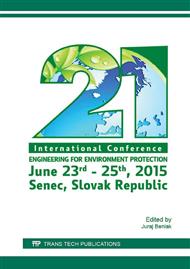p.177
p.184
p.192
p.200
p.207
p.213
p.218
p.224
p.231
Feedback FEM Analysis to the Material Properties in the Simulation of Radial Pressure in the Cylindrical Chamber
Abstract:
An article is about mechanical effect of the physic-mechanical material properties on the radial pressure in the compression chamber during the compacting process of wood. Some general methods that describe the transformation process of axial pressure into the radial pressure are shown, As well as the mathematical or experimental methods specifying dependencies and physical conditions. Mathematical finite element method in this area is very useful, but rarely used. Common problems using FEM are the proper definition of the physical material properties in a particular stage of compaction. Material properties are greatly influenced by a number of factors such as moisture, fraction size, chemical composition, current temperature, radial macro structure, axial macrostructure, current pressure and others. The chamber material and the manufacturing processes or the state of wear has an impact on the physical conditions. In terms of tensile elastic deformations, these complex effects reflect and can be merged into several properties. The conversion of axial to radial pressure indicates that some properties of the compacted material have a major impact on the process, such as friction between material and chamber, elastic modulus and Poisson's ratio. The geometry of the pressing chamber also has a significant impact. This paper does not deal so much with the pressing chamber geometry but more so with the characteristics embodied in experimentally measurable quantities. The measurement of these properties in combination with the application of FEM methods proves to be a highly progressive method for understanding the compaction process and the engineering design of compaction machines for the production of briquettes and pellets. The article urges further examination and measurement of a wider range of material properties in the densification process.
Info:
Periodical:
Pages:
213-217
Citation:
Online since:
April 2016
Authors:
Price:
Сopyright:
© 2016 Trans Tech Publications Ltd. All Rights Reserved
Share:
Citation:


